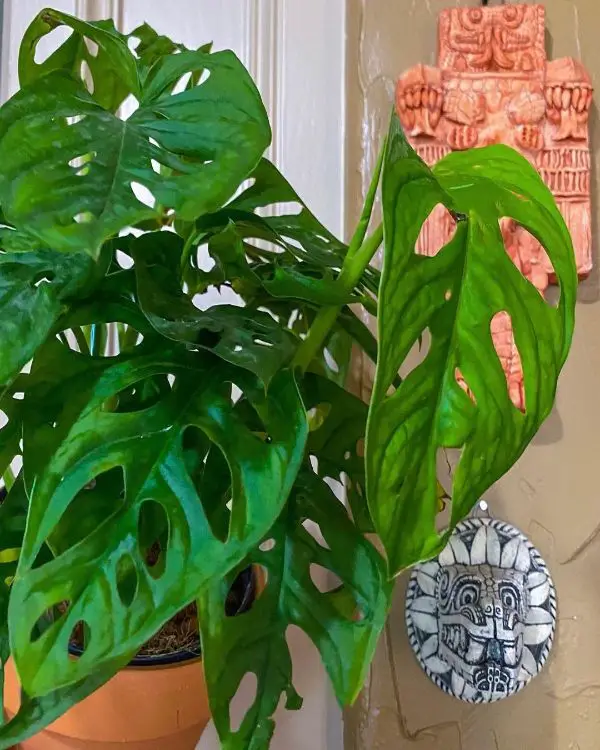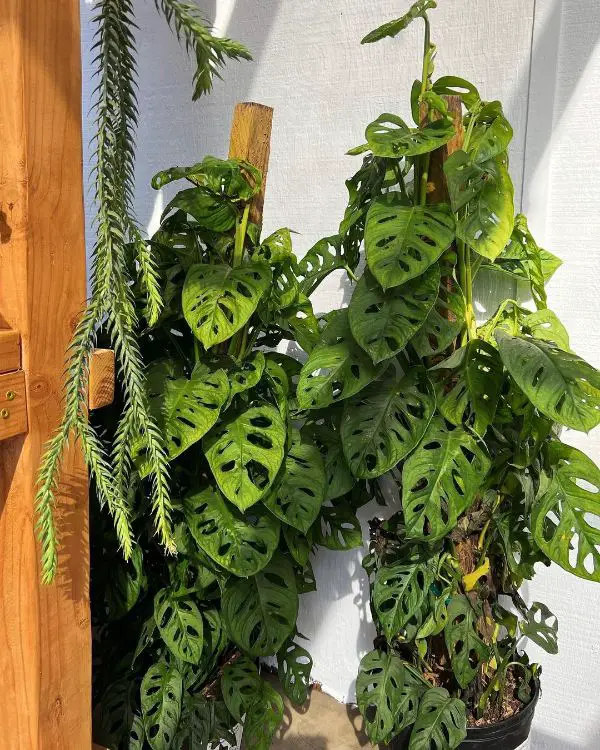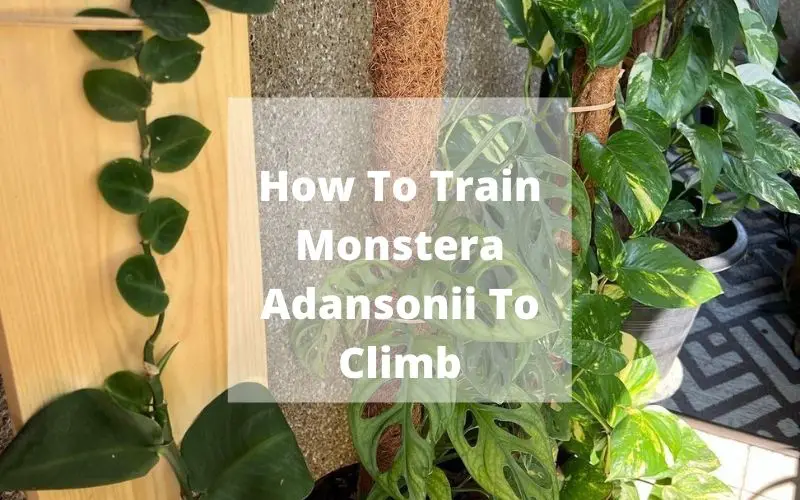The question of how to train Monstera Adansonii to climb seems easy but is a complex question of many factors. Including planting and caring techniques, you need to have a good grasp of the unique characteristics of Monstera Adansonii. Dig Nursery will help you answer this question below.
How to train Monstera Adansonii to climb?
To answer this question, you need to consider many factors:
- Related to propagation and planting techniques. How would you like to propagate and grow the Monstera Adansonii plant?
- It would help if you learned how to care for the Monstera Adansonii plant to grow smoothly and healthily.
- You need to arrange a moss pole for climbing plants.
You should buy ready-made moss poles, so you should make your own at home.

Besides, in the development process, the plant Monstera Adansonii can grow and develop in many dimensions. If what you want to know is how to orient the direction of the tree as you wish. Most of us will wish for the plant to grow vertically, spreading its leaves evenly and around. And no horrible health conditions such as small leaves, brown spots, black spots, yellow spots, or curled leaves.
You need to be fully equipped with knowledge about the Monstera Adansonii (Swiss Cheese Plant), how to care and how to grow it to ensure the best conditions for the tree.
Related Post: How to attach Monstera to a moss pole for your own?
Growth characteristics of the plant Monstera Adansonii
Monstera Adansonii grows with unlimited length. Leaves are oval and have many holes that grow and develop well, even in low-light conditions. This plant lives outside the South American countries in the West Indies. Islands like Antigua, Guadeloupe, and Dominica have become popular spots to see a wild plant species – Monstera Adansonii. Several other subspecies of Monstera Adansonii have become extinct due to deforestation.
In the wild, you won’t find this plant above ground. They are extremely powerful vines with remarkable growth ability. The ideal habitat is in low-light areas. Depending on where the plant is grown, Monstera Adansonii can vary in size and shape. Specifically, the way the leaves look and the holes in the leaves vary between types. Some plants, when grown, have much larger leaves than others. Some variants have somewhat rounded leaves, while others are more slender. There are two distinct forms called Round and Narrow.
- Narrow-leaf Monstera Adansonii. The leaves of the line Monstera Adansonii are narrow, smaller in width, and more slender than other species. They are usually longer, and the ends are pointed slightly to the side.
- Round form Monstera Adansonii. Round plants have the same holes in the leaves as the narrow ones, but the leaves are broader and more heart-shaped.

Species Monstera Adansonii Varienged, a particular species of Swiss Cheese Plant
There is another form of Adansonii, which is the Monstera Adansonii Varienged. This species is the most luxurious and noble version of the five-hole Swiss Cheese Plant. Even cuttings of Monstera Adansonii Variegata sell for thousands of dollars. The multicolored Adansonii will also grow slower than the green species. It is mainly due to the white parts of the leaves that don’t contain enough chlorophyll for photosynthesis.
In addition, completely white leaves will eventually turn brown and die. If your tree shows white leaves, you’ll need to trim the leaves underneath, and hopefully, the tree will suffer minor damage. How to train Monstera Adansonii to climb well, you should learn each characteristic of Monstera Adansonii to make sure everything is on the right way.
Planting method for Monstera Adansonii
There are two ways of planting this kind of Monstera: one is planting with soil, and the other is with water. Planting Swiss Cheese Plant successfully is a way to train Monstera Adansonii to climb.
Planting Monstera Adansonii with soil
Monstera Adansonii is suitable for porous, aerated, well-moisturized, nutrient-rich soil. You can use a mixture of mud and add charcoal for a long time. It is necessary to build a climbing pole or put a stake so that it can climb. If not, you can let it rise on another tree.
Planting with water
Wash the roots of Monstera Adansonii, then place it in a pot or container with a growing solution. First, you need to choose a glass vase to plant the plant. You can easily find or buy these jars. In addition, you can refer to the glass porcelain flower vase if you want to grow a large tree in the house. It’s best to start with unrooted stumps so you can see the roots grow. Then you’re better off choosing a vase with a darker color that will block out light and slow down moss growth, or else you’ll find yourself having to clean the moss quite often.
Pay attention to choosing a clean water source for growing plants. You should add more fertilizer to the water. Add fertilizer after 4-6 weeks. And change the water regularly 2-3 times a week before removing moss from the vase. The best way to grow it in water is to use something like an old toothbrush or a cloth to scrub the moss off the sides of the jar. You can also wash the jar periodically. While emptying the container, you can transfer the plant to another pot full of water or a bucket of water.

How to take care of Monstera Adansonii to help it climb well
Monstera Adansonii is very easy to grow. Living in a lack of sunshine can also grow well. The tree should be placed with natural light, and shady because it is a shade-loving plant, suitable for medium-light intensity. Growing Swiss Cheese Plants outdoors requires a roof. Otherwise, the plant will turn yellow and burn its leaves or die.
Location at home: You should not place the aquatic Monstera Adansonii near the glass door or in strong sunlight. Every week, bring the plant out to dry in the sun once in the early morning for about 15-30 minutes.
Temperature: The best growing temperature of betel nut is 150C – 300C. The tree does not tolerate cold, so it is necessary to ensure that the temperature is above 8 degrees Celsius when it is hard.
Water schedule: Monstera Adansonii is a moisture-loving plant, has high water requirements, is not drought tolerant, and is watered once a day. But when watering, it is necessary to avoid too much water, causing waterlogging, the plants will turn yellow and rot. As for aquatic plants that need to be changed once a week, water is only to cover 2/3 of the roots.
Soil requirements: the plant prefers well-moisturized, nutrient-rich soil. It combines rotting manure + soil + charcoal for a long time. The plant’s nutrient requirements are low, so you do not need to use a lot of fertilizer for the plant. Occasionally add a bit of soluble foliar fertilizer with water to water the plants.
Pests and diseases: Monstera has few problems, but it also suffers from common conditions such as mites, aphids, root rot, etc. It is possible to use common pesticides and plant protection drugs at that time. You should regularly pick up yellow leaves to change the water to limit pests.



